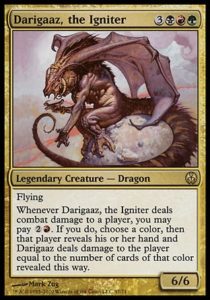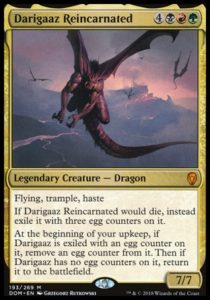Expanding Brawl into older Standard formats allows for Dominaria to be an even more nostalgic set than it already is. When I went through my initial Eternal Brawl deckbuilding phase, I decided Darigaaz, the Igniter would be my Commander for Invasion block-era Standard, largely because Darigaaz Reincarnated was coming out. As I built the original Darigaaz deck, it turned out that a lot of the best themes for it – ramp, Saprolings, and bombs with kicker and Thorn Elemental for support – were just as doable in 2018 as they were in 2001.
Or, as was sung in 1996,
“The only difference / Darigaaz sees / is his deck’s exactly the same / as it used to be.”
I’d like to talk about Brawl decks for both Darigaazes today, with two goals in mind: to show how different 2001 was from 2018, and to demonstrate how fun Eternal Brawl can be.
2001: A Multiverse Non-Odyssey
The first thing to figure out for an Eternal Brawl deck is which Standard format’s card pool you’ll be using. In Darigaaz‘s case, there are three to choose from:
6th Edition, Masques block, Invasion/Planeshift
Masques/Invasion blocks, 7th Edition
Invasion/Odyssey blocks, 7th Edition
I knew I wanted to bring multiplayer all-star Pernicious Deed to Brawl, and the inclusion of Apocalypse meant that 7th Edition was my core set of choice. (Thanks to core sets having their own rotation schedule back in the day, 7th Edition came out in the middle of Invasion block, meaning 6th Edition and Apocalypse were never in Standard together.) I initially thought a Jund (or, back then, Darigaaz, I guess) deck involving Invasion block would pair best with Odyssey block, given the Odyssey filter lands (like Shadowblood Ridge) and removal (like Decimate). But the themes didn’t overlap enough to form a coherent deck. Masques block provided more of the kinds of ramp I wanted to pair with Pernicious Deed (i.e. not mana dorks), and it also provided two of the bombiest bombs that ever did bomb multiplayer: Avatar of Woe and Plague Wind. Put it all together, and the middle option, Masques/Invasion/7th, was the sandbox I bought Darigaaz.
So, what does 2001 Darigaaz like to do? Here’s the deck in full.
Ramp
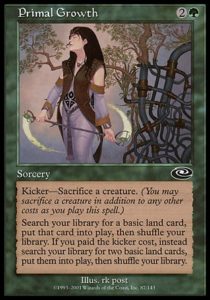

As I’ve discussed previously, Brawl requires you to ration your board sweepers as if you’re playing Sealed, and maximizing Pernicious Deed meant forgoing Birds of Paradise and Llanowar Elves so I wouldn’t ramp up to my own card disadvantage. Vine Trellis is a good enough blocker that I was willing to include it; I was also low on turn-two plays, which seems bad for a ramp deck. Thunderscape Familiar was included for the same reason. Rampant Growth, Harrow, Wood Elves, and Skyshroud Claim all see heavy Commander play. Silverglade Elemental is a bigger Wood Elves; Untamed Wilds was good before ramp spells passed it by; Primal Growth is Untamed Wilds that sometimes kicks into two lands; Clear the Land can ramp everybody, but you benefit most from it.
Besides Pernicious Deed, the other reason to ramp this way is that 2001 Standard didn’t give this color combination many good ways of drawing cards. Apocalypse provides the excellent Phyrexian Arena, but outside that, the best way of getting card advantage in this deck is to have cards find other cards, and ramp’s the most straightforward way of doing that. By the endgame, hopefully most lands are out of the deck and Darigaaz is drawing nothing but his beefy friends.
Saprolings
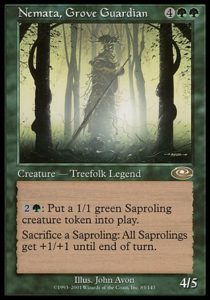
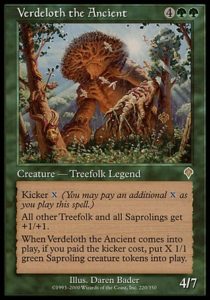
Not every opponent will fold to Darigaaz and his beefy friends, and with the big mana advantage this deck can generate, it’s good to have mana sinks. Two of the best – Nemata, Grove Guardian and Verdeloth the Ancient – happen to make Saprolings, so adding Artifact Mutation and Death Mutation as utility makes sense. Combined with the Insect tokens made by tough blocker Saber Ants, there are loads of tokens available to pump Beast of Burden, which was nearly continuously in Standard from 1999-2007 and should make most Eternal Brawl decks of that era.
Bombs
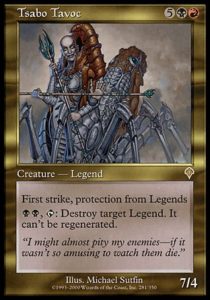
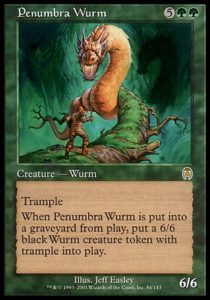
Darigaaz, the Igniter is a bomb himself, but he gets Avatar of Woe, Nemata, and Verdeloth to help out, along with legend-killer Tsabo Tavoc. (Note that the Oracle text allows Tsabo to kill legendary creatures only – Planeswalker Commanders are safe.) Spiritmonger was a powerhouse in its Standard day, and while its color-changing ability isn’t as relevant to modern-day removal, the regeneration ability has increased in relevance. Thorn Elemental and its handy pseudo-trample gets a friend from Nemesis in Rhox; as with Spiritmonger, Rhox‘s regeneration looks better in a world of Fumigates than Wraths of God. Penumbra Wurm doesn’t regenerate, but its post-death Wurm token is roughly the same thing.
Are Sweepers Bombs?
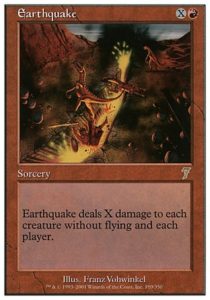

As with basically every Eternal Brawl deck made from the first decade of Standard environments, Earthquake and Hurricane can be both bombs and sweepers depending on your needs. Commander players are used to creature toughnesses outpacing mana development pretty quickly – what’s Earthquake going to do against Animar, Soul of Elements? – so these two spells aren’t as ubiquitous as they were in the past. In Brawl, however, they keep pace with the board, and because they also damage each player, you can scale them to finish off the weak. Breath of Darigaaz is a small Earthquake that is both flavorful and effective, while Void helps blow up the outside world.
By the way, Invasion block also gave the world Hull Breach, Terminate, and Tangle, and they’re great. Tangle is an ideal Fog effect for Brawl; it creates a surprising opening on somebody else. Good enough!
2018: Return of the ‘Gaaz
Don’t ask how Mark Morrison predicted this before Invasion was even out (a prophet never reveals their secrets…); here’s the deck in full. I made it with only Ixalan-forward cards so it naturally survives October rotation; this deck will only get better, and it’s already good. (I also took my own advice from my last article and included Crushing Canopy. Sometimes improvements are obvious to the naked eye.)
This is what you can do with just three sets in Brawl.
Ramp
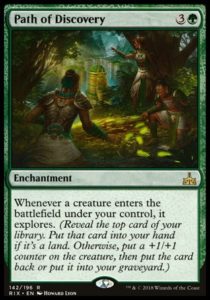
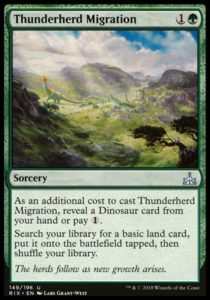
Llanowar Elves didn’t make the original Darigaaz deck, but there’s no Pernicious Deed this time, so they show up here. After that, it’s slim pickings compared to 2001, but it gets the job done. Thunderherd Migration is Rampant Growth if your hand has a Dinosaur; Grow from the Ashes is Untamed Wilds that sometimes kicks into two lands; Ranging Raptors will ramp if it blocks; Wayward Swordtooth, Broken Bond, and Llanowar Scout provide extra land drops; and Path of Discovery keeps the lands flowing and the creatures big. Additionally – and this enables the Pernicious Deed parallel, even if only to protect against Hour of Revelation – four of the Ixalan block transform lands provide extra mana and value on the flipside. And although it isn’t ramp, just having Evolving Wilds around is nice – when you get into the back pages of Eternal Brawl and want to build three-color decks, you miss the Wilds.
Saprolings

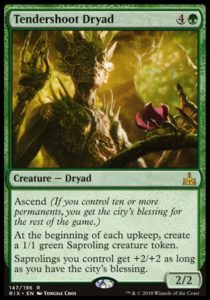
The theme doesn’t have as many strong cards as Invasion block did, but when the good ones show up, they work. Slimefoot, the Stowaway is as good a mana sink as Nemata, Grove Guardian, while Tendershoot Dryad and Verdant Force are differently-sized versions of each other. It would be amazing to have a combined-function card like Artifact Mutation available, but Saproling Migration and Spore Swarm will provide enough to get by.
Bombs
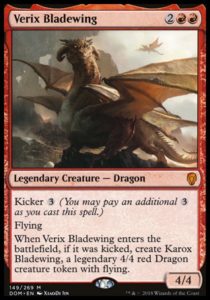

Thorn Elemental’s back, but it’s again the supporting actor for a star-studded cast. This time, the rare and mythic kicker creatures provide more curve flexibility than 2001 Darigaaz gets; while Etali and Tetzimoc cost a lot, Josu Vess, Verix Bladewing, and Territorial Allosaurus fill whatever mid-to-late-game role you need. Sunbird’s Invocation is a card-advantage bomb; since kicker is an additional cost, if the Invocation reveals a kicker card off the trigger, you can pay into it and get major value.
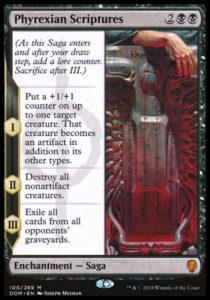
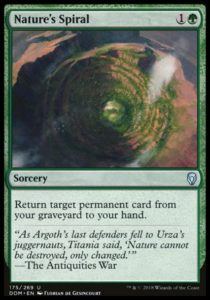
Unfortunately, there isn’t a Hurricane-type sweeper available in Standard, but there are still plenty of good ones. Tetzimoc is the meatiest part of a Plague Wind, Star of Extinction hits everything you need it to, Fight with Fire can kill as much as it wants, and Phyrexian Scriptures has extra value after it wipes the board. On top of that, the Scriptures can be bought back with Nature’s Spiral; keep Nature’s Spiral in mind for your deck, as Sagas provide the format with sorcery-style effects on permanents.
Conclusion
With a new set so heavy on nostalgia, the ability to make an old and new Darigaaz Brawl deck with remixes on the same theme is loads of fun, and I strongly recommend doing something similar with any of your favorite legends. Grand Warlord Radha, Jaya Ballard, Jhoira, Multani, and Squee have all been depicted on older cards, and all except Jhoira can be built similarly to each other in the way these Darigaaz decks came together.
The beauty of Eternal Brawl is that it allows us to put the past and the present on an equal playing field. And whether you like Darigaaz to be a 6/6 for six or a 7/7 for seven, he’s a total blast as a Brawl Commander.

Brandon Isleib plays a lot of Commander and Brawl and loves finding the intersection of unusual and effective plays. He worked for Wizards of the Coast in 2014, he has put flavor text on a few cards, and he’s partly responsible for “create” being the word for cards making tokens. He is a legislation editor for the city of Seattle, he has written a baseball book, and he is proficient at making his bio sound more impressive than it is.


